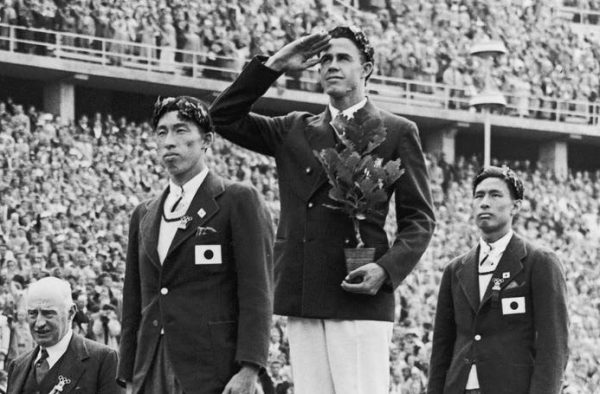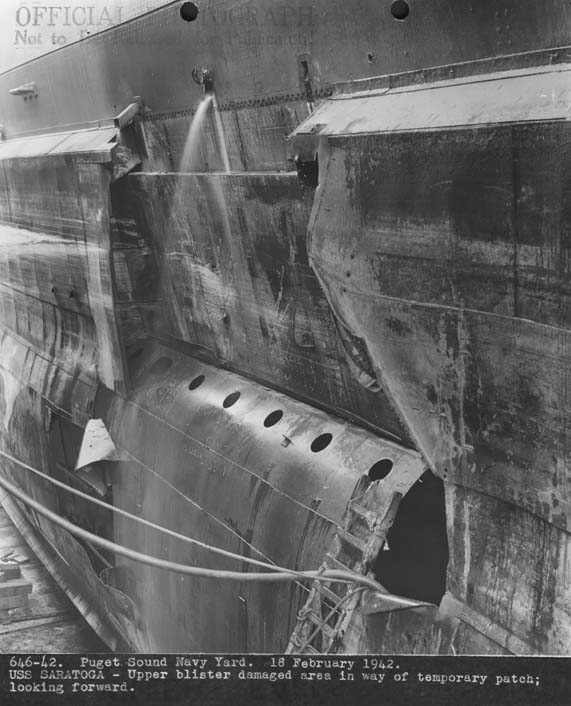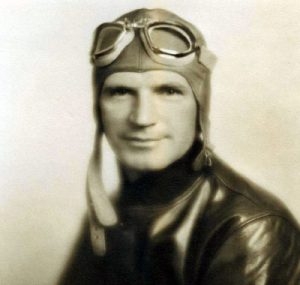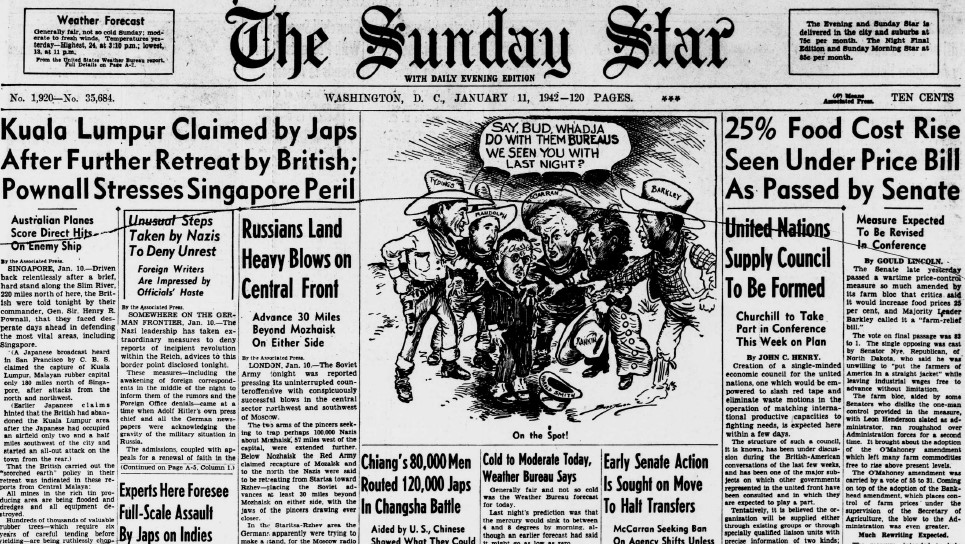World War II Chronicle: January 11, 1942
Click here for TODAY’S NEWSPAPER
On the bottom of the front page is a report on three men from the destroyer USS Kearny who have been awarded the Navy Cross for valor when their ship was attacked by a German U-boat. Find out more in the February 1942 edition of “All Hands” (pages 10-15). Kearny is currently undergoing repairs in Boston and will resume convoy duty in April…
Pictured on page 2 is Fort Drum in Manila Bay. The fortress is essentially a concrete battleship with 14″ guns and a spotting tower… Sports section begins on page 34… Jimmy Doolittle has orders changing his duty station from Detroit, Mich. to Washington D.C. (page 63). Doolittle had been advising automobile producers as they shifted to aircraft manufacturing.
Olympians in war

On the bottom of today’s front page is a brief mention that Japanese pole vaulter Sueo Oe was killed in action in the Philippines. The pole vaulter-turned-soldier placed third in the 1936 Olympics, which were held in Nazi Germany. That year the top five pole vaulters were all from either the United States (who took gold) or Japan.
11 American Olympic athletes are killed during World War II:
- Just after World War I, Paris held the Inter-Allied Games, a competition for former allied soldiers, where former Marine artillery officer Charley Paddock was declared the first “fastest man alive.” In the 1920 Olympics he won gold in the 100 meter and 4 x 100 meter races. He also earned silver in the 200 meter event, returning to Paris four years later where he again earned the silver in the 200 meter. Paddock rejoined the Marines during the second world war and was killed in a 1943 plane crash in Alaska along with Medal of Honor recipient Maj. Gen. William P. Upshur, who earned the Medal of Honor for actions in Haiti.
- Linn Farish scored two tries for the Americans as they defeated the French in Paris for the gold (1924). He served with the Canadians and the British before being transferred to the Office of Strategic Services and was awarded the Distinguished Service Cross posthumously while conducting a reconnaissance mission in the Balkans.
- Tommy Hitchcock was one of the Americans who volunteered for the French Air Force’s Lafayette Escadrille. He was shot down and captured by the Germans, but managed to escape and walked 100 miles over eight days to Switzerland. He returned to France after the war as part of the team that earned silver in polo (1924). During the second world war, he helped develop the P-51 Mustang and was killed during a test flight in 1944.
- Naval Academy graduate Heywood Edwards finished fourth in the light-heavyweight division of freestyle wrestling (1928). He became skipper of the destroyer USS Reuben James, and was one of 100 officers and men killed when his ship was attacked by a German U-boat before the United States and Germany were at war…
- Frank Cuhel, a former University of Iowa track star and silver medalist in the 400 meter hurdles (1928), was a war correspondent that died in a Boeing Clipper crash in Portugal in 1943
- Despite measuring just 5’5″ tall Foy Draper was one the fastest men in the world. He ran the third leg of the 4 x 100 meter relay team, which also featured Jesse Owens. Draper was killed while piloting his A-20 Havoc attack plane during the Battle of Kasserine Pass.
- Clayton J. Mansfield graduated the U.S. Military Academy in 1928 and began training for the modern pentathlon. Mansfield was one of three West Pointers competing in the event, along with Richard W. Mayo and Brookner W. Brady. Mayo earned the bronze and would become Fifteenth Army’s assistant artillery officer. Brady became Gen. George S. Patton’s provost marshal in North Africa (Patton himself competed in the pentathlon in 1912) before taking command of the 339th Infantry. Col. Mansfield commanded the 66th Armored Regiment and was killed in action shortly after being awarded the Silver Star for valor. His son Capt. Clayton Mansfield Jr. (U.S.M.A., Class of ’59) would be killed in Vietnam in 1965.
- John Turnbull competed in two olympics, earning gold as captain of the lacrosse team in 1932 and returned to play hockey in 1936. He enlisted in the National Guard in 1940 and quickly earned his commission. A lieutenant colonel by 1944, German flak shot Turnbull’s bomber down over France. Called the “Babe Ruth” of lacrosse, he was inducted into the Hall of Fame in 1965 .
- Walter Hasenfus and brother Joseph finished fifth in a two-man canoeing competition in 1936. He was killed in action in 1944 while serving with the 307th Infantry, 77th Division in the Southwest Pacific.
- Billy Fiske won two gold bobsledding medals (1932 and 36) before pretending to be Canadian and becoming perhaps the first American pilots to fly for the Royal Air Force. Of seven known Americans to fly during the Battle of Britain, Fiske was the first to die. Just one pilot survived.
- Idaho’s Ted Kara was the NCAA’s first-ever three-time boxing champion before his elimination in the quarterfinals of the featherweight division (1936). 2nd Lt. Kara served as a radar operator with the 418th Night Fighter Squadron and was lost at sea when his B-25H was lost in the Southwest Pacific in 1944.
Records show 50 athletes died in Nazi concentration camps and seven Polish athletes were killed during the Katyn massacre.
USS Saratoga torpedoed
On Jan. 9, a Japanese submarine spots a Lexington-class carrier northeast of Johnston Island and Sixth Fleet scrambles to form a picket line. The next day I-6 spots numerous American aircraft throughout the day, and the sub’s navigator uses the planes’ courses to plot an intercept course for the enemy flattop. The following evening I-6 spots an American destroyer and submerges. Soon Saratoga comes into view, and at 1915 the Japanese sub fires three torpedoes. One impacts the American carrier on the port side, killing three sailors and causing the ship to list to the port side.
The task force’s screening ships begin hunting for the submarine, whose crew believes from the sound of explosions that they have sunk the carrier. Saratoga limps back to Pearl Harbor for temporary repairs (see image below), having been knocked out of combat for months. Considering the crippled condition of the Pacific Fleet, this engagement is not reported. Killed are WT2 Marshall T. Hornsby, WT2 Arthur W. Johnson, F2 Victor R. Molthen, F2 Aloysius W. Prymula, F1 Osborn K. Rainwater, and WT1 Thomas R. Taylor.


Saratoga‘s skipper is Capt. Archibald H. “Toots” Douglas, who made the All-Southern Team when he played football for the University of Tennessee in 1902. Accepting a nomination to the Naval Academy, Douglas was team captain in 1907 and was an All-American back for the Midshipmen in 1905, ’06, and ’07. He also played baseball for both Navy and Tennessee. After graduating he served with the Northern Bombing Group during World War I.
